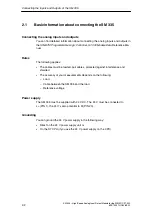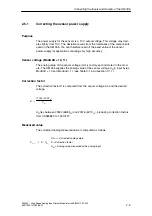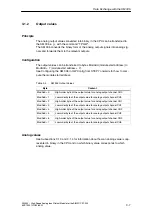
Connecting the Inputs and Outputs of the SM 335
2-4
SM 335 – High-Speed Analog Input/Output Module for the SIMATIC S7-300
6ES7 335-7HG00-8BA1
Non-Isolated
In contrast to other applications (e. g., when connecting thermocouples), you
should ground the sensors’ analog zero potential in the vicinity of the SM 335. The
easiest way to do so is to connect pins 10, 12, 14 and 16 with analog zero potential
M
ANA
(PIN 6) and connect M
ANA
in the vicinity of the module in the rack with the
central grounding point (CGP) of the module. This connection should be as short
as possible.
Do not ground the sensors twice, however, as this would produce ground loops,
which could result in interference. When using sensors, which are shielded and
whose shields are connected to the analog zero potential, you must disconnect the
shield from the analog zero potential.
Limited potential difference U
CM
Only a limited potential difference U
CM
(common mode voltage) may occur bet-
ween the measuring lines M
-
of the input channels and the reference point of the
measuring circuit M
ANA
.
In order to prevent the permissible value being exceeded, you must take various
action, described below, depending on the potential connection of the sensors.
For details please see the SIMATIC Programmable Logic Controller, S7-300 Mod-
ule Data Reference Manual.
If you use the SM 335 isolated, the maximum permissible common mode voltage
must not be exceeded between the zero potential of the sensor and M
ANA
, other-
wise the SM 335 triggers a diagnostic alarm and 7FFF
H
is read in from the relevant
channel.
60 V AC/75 V DC must not be exceeded between M
ANA
and the ground of the
24 V voltage supply.
Unused analog inputs
Unused analog inputs on the SM 335 must be short-circuited and connected to
M
ANA
. Deactivate the unused analog inputs as described in HW Config. This
achieves the optimum in interference immunity for the SM 335 and the cycle time
is reduced in the operating mode “free cycle”.
You can also employ unused analog inputs to monitor the sensor power supply or
analog outputs. This also enhances interference immunity.
















































